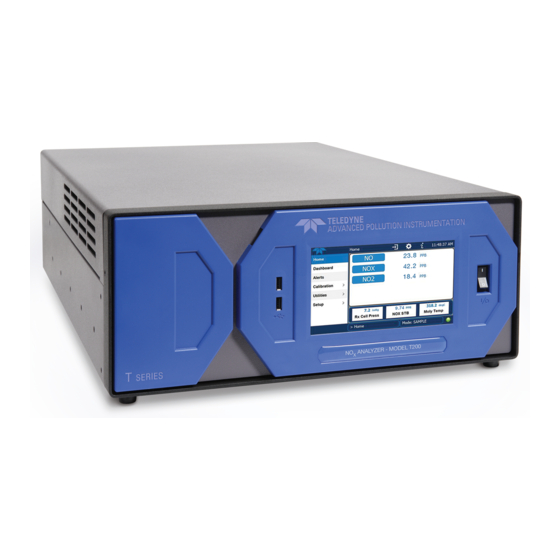
Teledyne T200 Manuals
Manuals and User Guides for Teledyne T200. We have 4 Teledyne T200 manuals available for free PDF download: Operation Manual, User Manual, Training Manual
Teledyne T200 Operation Manual (452 pages)
Nitrogen Oxide Analyzer
Brand: Teledyne
|
Category: Measuring Instruments
|
Size: 9 MB
Table of Contents
-
Warranty7
-
Introduction27
-
Front Panel33
-
Rear Panel36
-
Shock Hazard40
-
Zero Air49
-
Start up54
-
Faq's63
-
Glossary65
-
Sample Mode92
-
SETUP Mode97
-
Das Status113
-
Led State113
-
DAS Structure114
-
DAS Channels114
-
Report Function126
-
AIN Calibration151
-
Remote Operation153
-
Machine ID159
-
Command Syntax161
-
Data Types161
-
Status Reporting162
-
Communication168
-
Mode Description177
-
Zero Air186
-
Span Gas187
-
Permeation Tubes187
-
CAL on no194
-
Feature194
-
Mode Name203
-
Zero Air213
-
Span Gas213
-
Record Keeping213
-
Zero Calibration220
-
Span Calibration220
-
Gpt no221
-
Check221
-
Precision Check223
-
References225
-
Optical Filter230
-
Nox231
-
Auto Zero232
-
Light Leaks234
-
Sample Gas Flow236
-
Vacuum Manifold238
-
The O Generator241
-
Ozone Scrubber244
Advertisement
Teledyne T200 Operation Manual (425 pages)
NO/NO2/NOX Analyzer
Brand: Teledyne
|
Category: Measuring Instruments
|
Size: 10 MB
Table of Contents
-
Warranty7
-
Introduction17
-
Features17
-
Options18
-
Safety23
-
Emc23
-
Front Panel27
-
Rear Panel31
-
Start up66
-
Interferents70
-
Sample Mode76
-
Setup Mode81
-
INET (Ethernet)101
-
Signal I/O106
-
Optic Test124
-
Electrical Test124
-
Flow Calibration124
-
Com Port Testing128
-
128130
-
Ethernet131
-
Modbus138
-
Hessen140
-
DAS Structure150
-
DAS Channels150
-
Remote Operation171
-
Computer Mode171
-
Interactive Mode172
-
CAL on no189
-
Feature189
Teledyne T200 User Manual (232 pages)
NO/NO2/NOX Analyzer with NumaView software
Brand: Teledyne
|
Category: Measuring Instruments
|
Size: 17 MB
Table of Contents
-
Warranty6
-
-
-
Unpacking20
-
-
Front Panel22
-
Rear Panel23
-
-
Startup55
-
Calibration57
-
-
-
Setup>Events69
-
Setup>Vars73
-
Com1/Com281
-
TCP Port182
-
TCP Port282
-
TCP Port382
-
-
-
-
-
Zero Air94
-
Interferents96
-
-
-
-
-
Remote Updates111
-
-
-
Flow Problems143
-
High Flow146
-
Excessive Noise152
-
Slow Response152
-
AC Main Power154
-
DC Power Supply154
-
I 2 C Bus155
-
Motherboard156
-
Relay PCA156
-
Cpu159
-
O 3 Generator165
-
Advertisement
Teledyne T200 Training Manual (102 pages)
NITROGEN OXIDES ANALYZER
Brand: Teledyne
|
Category: Measuring Instruments
|
Size: 5 MB
Table of Contents
-
User Notes24
-
Maintenance39
-
User Notes42
-
User Notes85
-
Front Panel89
-
Rear Panel94
Advertisement



